#how to draw mosque with colour
Explore tagged Tumblr posts
Video
youtube
Mosque Drawing with Oil Pastels | Mosque Drawing Beautiful Easy Step by Step
It is about mosque drawing with oil pastels beautiful easy and step-by-step. Mosque drawing with color is really easy as you'll see in this mosque drawing tutorial. Learn mosque drawing step by step or how to draw a mosque with colour.
Know how to draw a mosque and Masjid drawing tutorial pencil drawing easily. Materials you'll need: Drawing paper, Gel Pen, Ruler, Pencil, and Oil pastel Colors Follow the steps below:
1. Draw a large rectangle in the middle of the paper..
2. Draw a large dom in the middle of the top and two domes beside the main dome of the mosque.
3: Draw a large door in the middle. Draw some windows on the right and left sides of the door.
4. Add details like doors and windows. Draw lines to show the floor separations.
5. Use colors to bring your drawing to life, as my tutorial shows. You can give it a different color if you want.
🛡️ LIKE ✅ COMMENT ❇ SHARE✅ SUBSCRIBE 🛡️
✅꧁𝓢𝓾𝓫𝓼𝓬𝓻𝓲𝓫𝓮꧂: https://www.youtube.com/c/FarinKhanArtAcademy
📌 Pinterest: https://www.pinterest.com/farinkhan2007
📌 Facebook: https://fb.me/HowToDrawingTutorialForKids
📌 Twitter: https://twitter.com/sweetdhaka
📌 Instagram: https://www.instagram.com/farinkhan2007
.#mosquedrawing #simpledrawing #simpledrawingforkids #simpledrawingideas
#youtube#mosque drawing with oil pastels#mosque drawing beautiful#mosque drawing easy step by step#mosque drawing with color#mosque drawing tutorial#mosque drawing step by step#how to draw mosque with colour#how to draw mosque masjid drawing tutorial pencil drawing easy#how to draw mosque easy
1 note
·
View note
Text
i love being southeast asian.
despite whatever unhappy history, despite the rise of ethnonationalism and racism in our countries; despite the fact that most of us remain in the global south under the invisible thumb of western empires and conglomerates, exploited by rich expats and beg-packers; despite the conservatism, the bigotry, the pain and prejudice and the corruption.
despite all that, i love where i am from. this is my home.
my hands tenderly trace the lines of our history and find within it a colourful collection of influences that continue to shape us until today:
the native malays, javanese, sundanese, minangkabau, bugis, visayan, tagalog, and other dominant peoples.
alongside indigenous tribes like the iban, kadazan, sama-bajau, temuan, penan, jakun, and hundreds upon hundreds more ethnic groups.
all of us holding onto our ancestors' mysticism and spirituality and animism, the watchful gaze of legacy fixed on us as we move through an ever-changing and modernising world (and what is modernity anyway? isn't civilisation overrated?).
and then the chinese peoples. the hainanese, hokkien and cantonese and more, many of whom came here due to trade in the pre-colonial era, but then most arrived as the imported labour for the colonial powers.
but this is their home too. we live here together, and through them we all celebrate lunar new year and the mid-autumn festival. all of us give red envelopes during our many festivals. we give oranges that symbolise prosperity and ring in the year of the rabbit, dragon, snake, horse, goat. we hold lion dance performances in our malls and marks. we eat and exchange mooncakes.
and then the indian peoples, though mostly tamil indians from south india, but also sikhs, malayalis, and punjabis, who arrived and assimilated and spread their culture and beliefs much earlier before the pre-colonial era, causing the indianisation of southeast asia. then more indian peoples came during the colonial era, again, as imported labour, working our fields or donning the uniform of our common oppressors, kept walled away from us despite how alike we look and sound.
because truly we do sound the same. sanskrit remains an abundant source for a large chunk of our languages. i hear the vedic mantras and can pick apart words that sound familiar. hinduism and buddhism still leaves its traces in our cultures even for those of us who've shifted to islam.
and yes, islam. we're not what the west thinks of when they talk about the muslim world, but southeast asia has some of the largest muslim populations in the world. because through trade, since the medieval times, islam came here and with it brought so many arabic influences that has come to shape our languages and customs, with plenty of our cultures having since been morphed around islamic beliefs and ideas. in malaysia and indonesia and brunei (and perhaps even certain parts of the philippines) you'll find a mosque or a prayer room everywhere you go. and every ramadan millions of us fast, every eid all of us dress up and visit each other's houses for feasts and festivities.
then of course came european colonisation at the hands of the portugese, dutch, british (in malaysia and indonesia's case we got all three), spanish, and french their reigns lasting over 400 years. and from them we came european culture and more new languages, english quickly becoming a second language (or even a first language) for so many of us, missionaries building churches and spreading the word of jesus christ as the son of god; with their fair features they draw a line between us and them, between the civilised and the barbarians, between the light-haired light-eyed and the unruly dark-haired dark-eyed.
and then comes world war 2 and the japanese invasion, and for most it was so brutal and violent, and for the rest it was miserable, with famine and inflation but we were forced to sing songs in japanese anyway, to watch their planes fly in the sky towards their enemies, to swallow their ideas in our parched throats.
and then the war ended and wounds began to heal, and then came the 1980s until now with all its shiny technology: nintendo, panasonic, television and anime, and now we have leagues of people learning japanese language and culture anyway, except now it is done wholeheartedly, and as it turns out japanese isn't even that different from our own cultures anyway. houses on stilts made of wood with thatch roofs, making our living from the sea and coast, eating rice for every meal, our phonetics and theirs so alike.
and today we have waves of their expats migrating here because of course they do, we're the Global South™ and for them it's cheap and affordable, so we have little japans sprouting here and there and sometimes i go to a random street and find signs written in japanese and read bits of broken hiragana.
and it's beautiful, being able to move through this world and find the handprints we've all left upon it. it's a wonderful amalgam of so many traditions and colours and beliefs and language all mixing around in this huge bubbling melting pot.
and i'm not chinese or indian or arab or british but when i see them on tv, i'm also seeing a part of me, i hear the words in their tongue and i recognise them as mine, i eat their food and know them as intimately as my own.
but of course our politicians, our kings and our prime ministers (and the divide-and-conquer rule of colonisers now gone) continue to divide us and make us hate each other, fanning flames of distrust and fear of that-which-is-different.
it's such a shame too, because it's so special. it's what makes us us, our dozens of creoles, the way we can speak a sentence comprising vernacular from at least four languages and we all understand each other anyway.
we have a word in malay, "rojak", which is also the name of a dish that mixes a bunch of different ingredients, and is found in malaysian, indonesian and singaporean cuisine. but where i'm from, we also say "rojak" to mean anything that's an eclectic mixture of things, things that seemingly don't go together and aren't necessarily pleasing to the eye but still, somehow, it works, in fact it tastes good, spicy and flavourful and hearty.
and that's us: southeast asia, all of it, a beautiful rojak culture. and it's ours.
#writeblr#people of color#writers on tumblr#writers of color#writing#southeast asia#asian culture#i woke up today and started feeling so many things. i looked around and felt full of love.#but i go on social media and it makes me angry and sad to see how much everyone hates each other#my love is not for what it is but what it could be#lots of my friends wish they could leave. emigrate to australia or UK or US. but even if i could i wouldn't.#this is my home. there is nowhere else.#when i was teaching and i saw those kids' faces it cemented it for me even more.#like if not for anything else i'll stay. i'll do it for them. carve out a community for them. for us.#shut up haydar#scribblings.txt
18 notes
·
View notes
Text
[id]
1: Rainbow letters reads, "How to resist an oligarchy," [Image shows five differently coloured people-shapes smiling and raising their arms in the air.]
2: "Oligarchy: a small group of people having control of a country, organization, or institution." [Image shows Donald Trump, Elon Musk, Mark Zuckerberg, and Jeff Bezos.] Text continues: "Their goal: For us to be overwhelmed, to ignore/avoid the growing information, and to feel helpless. "Our goal: Learn and focus on what we CAN do instead of why we can't.
3: Quiet Subversive: "If your calling is hiding ppl, driving women to clinics, mailing BC, or any illegal morally good activity, be paranoid. Social media is not your friend. Zuck, BlueSky, etc. will sell you out. In ordr to be a Jane, you have to assume your life, lives of your family/friends, and lives of the ones you are helping are in mortal danger. As soon as you blast, "I'll hide Ann in my attic," you are no longer safe and not useful for this kind of work." [An image of an elderly woman holding a tray of cookies. She is all coloured in yellow.]
4: Distributer: "This can be done by printing info, or providing online links. For groups and orgs that can take the heat, such as Planned Parenthood, sharing and boosting their posts can be helpful. If your calling is to print up red cards/make pamphlets, then anywhere you place this info is going to be targeted for destruction of materials. Regularly drop off info and find new ways to get the word out. For smaller groups that need to stay somewhat obscure, be selective about sharing info." [An image of a purple person handing out red cards to several other people coloured in purple.]
5: Financial Supporter: "Every dollar has a potential to do good. If you are able to put money towards a small business, especially if they are run by marginalized persons or groups, please do." [A purple image of a person in a small booth.] "The billionaires won't be hurt and it won't stop them from aligning with fascists but it will put money into hands of those needing to escape, needing aid, or in the hands of the above mentioned resisters. [Photograph of a group of people holding a Planned Parenthood banner. Drawing with an orange background with several different types of people holding rainbow flags. White text reads: Trevor Project: Saving young LGBTQ Lives"]
6: Church Goer: "Historically, churches/synagogues/mosques/temples have been a safe-ish place to gather in large groups and organize. Anyone familiar with the history of black churches, or churches under fascism, know there is potential for great good but also a risk of the church being burned, raided, bombed, or leaders being rounded up. Whether you are a theist or atheist, consider finding a community that can gather and organize in large groups and become a regular contributing member. As of 1/22/2024 ICE is legally allowed to raid churches, hospitls (sic), and schools under illegal immigrant suspicion. They need a JUDGE ISSUED WARRANT. You ARE legally allowed to look at it and demand it. [Several images of various places of worship]
7: Educator: "These come in many forms: building, first aid, critical thinking, self defense, fact checking, science, map reading, psychology etc. Anything that can help the quiet subversive, the information distributer (sic), the marcher etc. etc. be more effective; keep up the good work of long threads and videos. If you are not an expert, share media and videos from credible experts." [An image of several different coloured people (green, red, blue) in various clothes indicating careers such as camouflage, medic gear, professor]
8: Volunteer: "Soup kitchens, shelters, anywhere and everywhere people or animals are in need. Any and all good works towards our neighbors is resistance." [Image of several differently coloured people receiving food from blue coloured people at a yellow soup kitchen]
9: Marcher: "Marches can be used for paying attention to which groups are attending. Any group showing up with a banner is putting a giant target on themselves and they are going to need support. Volunteering with, or sending money helps them to continue showing up. The focus of a march is disruption which can potentially lead to becoming a target. Don't bring your phone. Don't share faces. Bring water and medical supplies. Be prepared to be pepper sprayed, smoke bombed, hit by a baton, harassed if your face is passed around among fascists, and/or arrested/imprisoned." [Images of people at protests either facing away from the camera or with faces blocked out]
10: Rest: "Rest can be resistance. From what I understand, it is about self care for the long haul. For more information, I recommend reading "Rest is Resistance" by Tricia Hersey" [Image of Rest is Resistance by Tricia Hersey] [Image of a yellow-coloured person wearing cozy clothes and holding a pencil over a notebook] "Create: Paint, write, draw, graffiti, design, music, videos, comedy. If you are a creative person, use it to spread awareness, help raise funds, etc."
[end id]




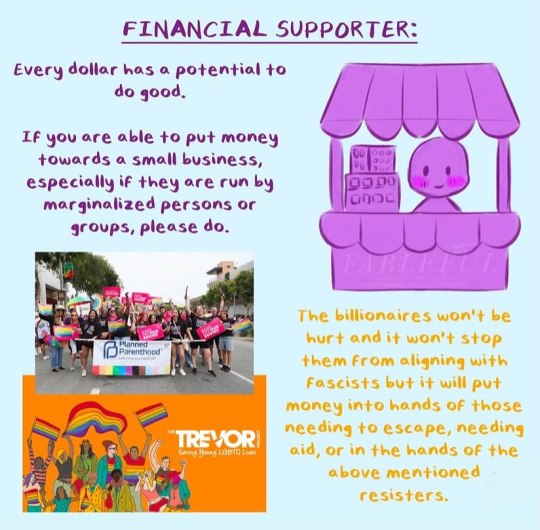





#Repost @gogreensavegreen
You might be more than one. You might be different ones at different times. 🫶🏽🫶🏽 you might not be one of these. There are more roles 💪🏽 but this is an amazing intro.
You can’t just like the idea and envision yourself in one of these roles you have to figure out how to be about it ♥️🫶🏽
Via @deiloh & @fablefulart
28K notes
·
View notes
Text


On this worksheet I created the first couple designs for the alien. The first design I thought was too generic and looked like something right from Alien so I ditched it quickly and came up with something more unique. The second design has potential and I'm going to use it as the baseline for other designs but I'd like to add more to it so it stands out even more. Aspects I would like to keep though is the reactive skin and the spear on its head. The alien lives in darkness so there's no need for vision, in the first design it had loads of sensors on its head but on the second design and the one I prefer its skin its made out of a liquid like texture that pulsates and when there is a sound. The skin will move in a different way depending on if its picking up a sound or a scent. The spike on the back of its head acts as its mouth and is essentially a massive straw, the alien can rotate its head 360 degree so the spike is now at the front of its head and then it sucks up whatever its eating, the sensors on the face are now on the back so it can pick up on any danger while the creature is in a vulnerable state. The skin can also be used manually and moved like any other limb to grab or attack stuff or it can make its whole body move and wriggle as a way to scare off predators like many animals that make themselves look bigger to intimidate other animals.
The floating monolith also has the same texture and moves in the same way showing that they are both of the same origin. The pattern on the skin looks like oil and has many different colours too it if you look closely.

At the point in time that my project is depicting the floating monolith has already been in the sky for thousands of years and its clear that ever since it appeared the world started dying but I wanted to expand the world and create a tiny bit of world building. When the monolith first appeared thousands of years ago no one knew what it was and many people had different opinions on what it was and eventually a religion was formed around it and people would gather round and worship it. I was inspired by The Kaaba in Saudi Arabia.

The Kaaba is the centre of Islam's most sacred mosque and is believed to be the first house of worship. Every year Muslims take a pilgrimage to The Kaaba called Hajj, thousands of people of people circle around it and try to touch it. To these people this so much more important to them than a black structure so I too wanted to create a mass worship around want seemingly seems as a construction but in people's hearts it's so much more to them.
But unbeknownst to the people at this time the thing their worshipping will actually be the eventual cause of the destruction of their planet so I'll be able to use this as a metaphor and talk about how toxic and detrimental religion can be and what extreme lengths people will go to in the name of their god like terrorism and the toxic morals that harm peoples lives, take Islam for example and how negative Muslim countries are around women and how they're whole religion denies them basic human rights and have them obey they're husbands and cover every bit of skin on their body which are rules from hundreds of years ago and so many countries and its respective religion has progressed and changed with the times so it's unfortunate that some places in the world are still living under these harmful social constructs. To represent this in my sci-fi world I'm going to have the monolith feed off its worshippers extremist acts in its name, make them believe what they're doing is beneficial but man's own destruction to society in the name of the monolith is what gives it power to draw energy from the sun and shroud the world in a apocalyptic darkness and the end of times and the end of structure is due to the peoples damaging beliefs.
In my opinion, I find religions very damaging. These morals that the texts preach are ancient and not relative to modern day views, living your life by imaginary rules I feel denies people of individualism and living by their own rules and becoming there own person as a result and not someone that has been shaped by their religious parents or what preachers say. Also that so many religions have harmful views towards gay people or any other minority it still makes those groups feel targeted in such a free period of time and perhaps people raised religious and then feel that they might be homosexual and how that impacts their mental health because they feel like they can't be their true self. So I think aspects of religion are severely outdated and therefore cause harm so that's something I'd like to discuss in the project and have as a subliminal message that's integrated in the lore of my world.
0 notes
Text
The Straits of Malacca and Moving On
I recently took a trip to see my dear friend Nurul in Kualar Lumpur, Malaysia, where she's been living for the past few years. She's a working girlie now and I had been on my two month world tour to see old friends and family. This was our state of mind when we met up and went on a long weekend trip to Penang, hoping to get some answers to our heart's most fervent burning questions.
I booked us a spacious Airbnb duplex with floor to ceiling windows that faced the coast, so we woke up to sunrise illuminating the vast expanse of the sea and distant shipping vessels every morning. And across the street stands a grand mosque that glimmers Gatsby green under moonlight. This is where we got answers to our questions.
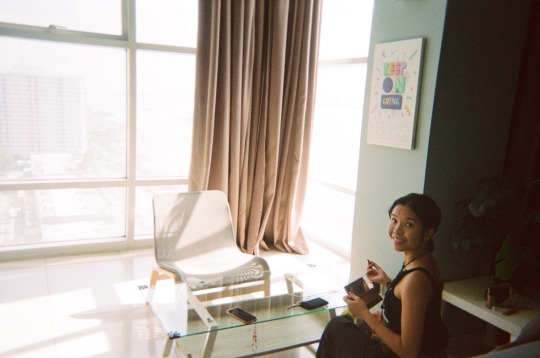
Nurul getting ready in the Penang airbnb
Before coming to Malaysia I had travelled through the Cambodian cities of Phnom Penh (my home city) and Siem Reap. My time in Phnom Penh were full of painful reminders of how my relationship with my family still needs to grow now that I've grown into my own personhood. But my time in Siem Reap opened my eyes to the possibility of choosing a simple life of love and community.
After a whole evening of heartfelt discussions and revelations, I realized that I needed to move back to Cambodia. My homesickness bubbled up to the surface and so did my distaste for the state of Australia.
Nurul and I were riding on that wavelength of being sick and tired of second-guessing ourselves and letting other's perceptions of us colour our own lived experience of the world. That night we shed all that dead weight off and basked in the sheen of our new skin. Together we glowed pink and purple.
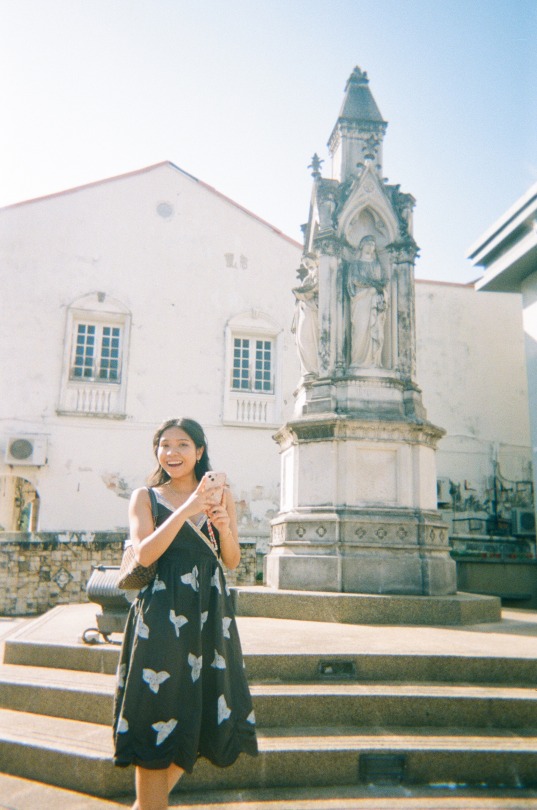
excursions around Penang
So what now?
I'm heading back to Cambodia, but this time I'll be living in Siem Reap. I can't wait to join my weird friends there! It's also a good place to lay low for a while and save some money towards future projects. I was also previously hum-hawing about going back to uni for a politics course, but nah not anymore. I have picked up digital drawing and painting! It's coming together slowly, I'm a great beginner at this and I think a lot of progress can happen in one year! Most importantly, I just feel giddy to get back into the arts scene in Cambodia. I've really missed home.
Thoughts about Melbourne, Australia?
It's alright but it's not for me...
I find it hard to relate to the narratives and ethos here. The people I do relate to are often other immigrants, especially South Asians. I think being an immigrant here takes a certain level of grind-set that I just can't muster up because I don't even see a future for myself in this country. I'll make a separate post about my experiences in Australia because it's a lot to get into.
But my final thoughts are: It was alright, the people are generally nice, but I'm ready to move on and I don't think I'll look back!
I'm ready to go home.
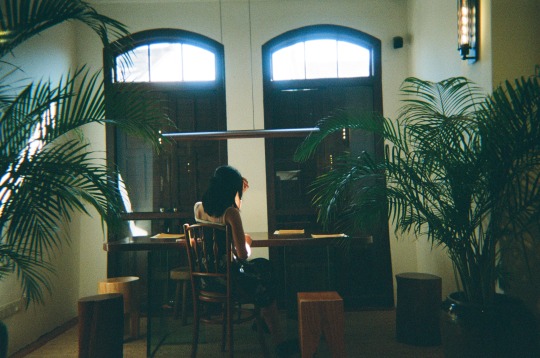
taken in a coffeeshop in Penang
0 notes
Text
Shahed Saleem creates mosque pavilion as a "reconstruction of migrant histories"

London-based architect Shahed Saleem has created a colourful pavilion in the shape of a mosque, which has been erected at the V&A museum as part of this year's Ramadan Festival.
Saleem, who is of Indian heritage, designed the pavilion for the Ramadan Tent Project's annual festival, which celebrates the holy month of Ramadan.
He drew on his own lived experience as a second-generation immigrant for the design while aiming to capture the collective feelings of distance that are sometimes endured by the wider Muslim diaspora.

This led him to design the pavilion as a reconstructed mosque with different architectural motifs and bright colours acting as various fragments of identity.
"As a child of immigrants I have experienced and learned how to negotiate different cultural worlds," Saleem told Dezeen.
"I have seen how migrant communities deal with loss and distance from homelands, and how they attempt to reconstruct and reassemble cultural memories and histories in a new place," he continued.
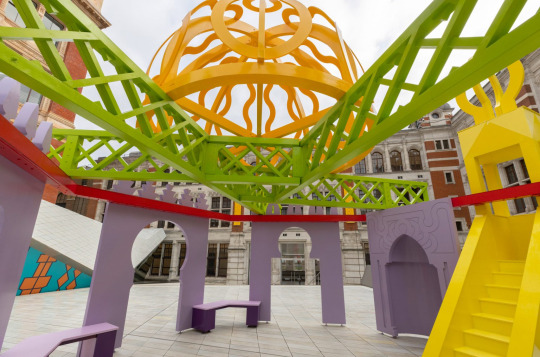
The pavilion is made up of elements found in mosque architecture including arches, a dome, a staircase, a roof and a mihrab – a semicircular niche that orients the direction of prayer.
"The pavilion represents this by showing historic fragments as being collaged and held together in a new structural frame," Saleem said.
"There is an overall sense of porousness and precarity, suggesting that the new narratives created through the reconstruction of migrant histories and experiences is an ongoing and dynamic process."
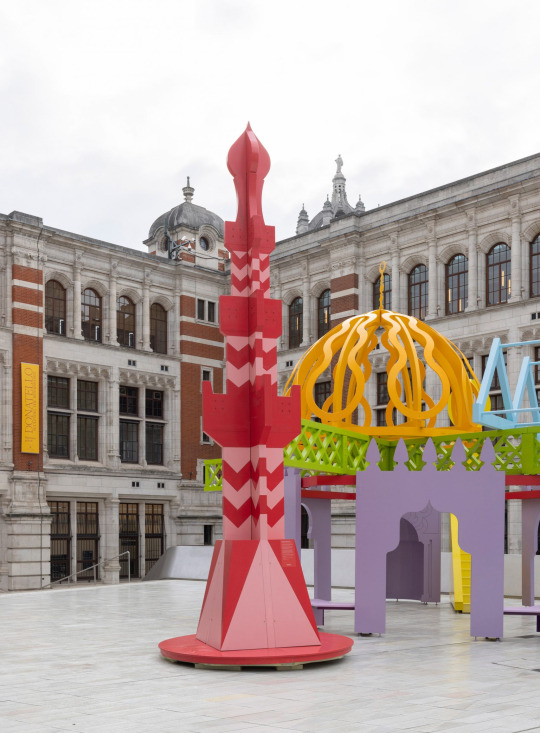
Saleem built the Ramadan Pavilion from plywood sheets glued and screwed together with steel brackets and fixings, while glulam timber was used for its structural and reinforcement elements.
Meanwhile, the minaret – the red and pink striped tower – has a vertical steel post and steel-framed base. In traditional mosques, the minaret is built into or stands next to the mosques and is used to call Muslims to pray.
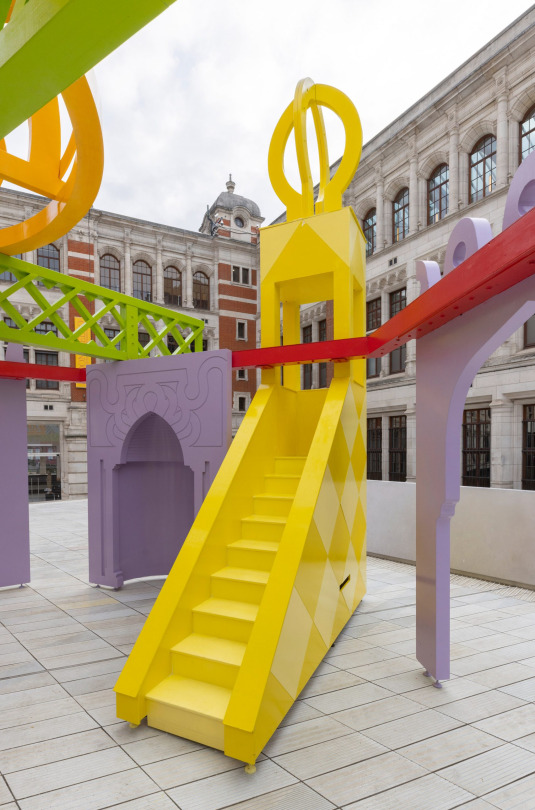
"Through the colours, finish and shapes, I wanted to give a sense of fun and playfulness, to suggest a childlike innocence and also to give joy," Saleem explained.
"This is because issues around migrants and Islam in Europe are highly politicised, and the aesthetics of the pavilion suggests that joy and commonality is also possible and offers another way of engaging with other cultures."
For reference, the architect turned to the Victoria & Albert Museum (V&A's) collection of prints and photographs of mosques and other examples of Islamic architectural design, as well as the architecture of British mosques from the 1960s to the present day.
"Each of these elements has been derived from 19th and 20th-century drawings and photographs in the V&A prints and drawings collection which depict historic Islamic architecture from north Africa to India," Saleem said.
"I have taken references from these images to create the elements for the pavilion. The pavilion is therefore a postcolonial reinterpretation of colonial representations of the Islamic world."

This year, Ramadan begins on Wednesday 22 March and lasts for 30 days. The month is observed by Muslims worldwide as a month of fasting, prayer, reflection and community.
The Islamic calendar follows the lunar cycle, which means that Ramadan falls approximately 10 days earlier each year in the Gregorian calendar.
Visitors to the Ramadan Pavilion will be able to attend a series of curated events, performances and workshops.
Mosques have been used as sources of inspiration for other installations around the world. Saudi Arabian artist Ajlan Gharem's Paradise Has Many Gates installation reimagines the traditional mosque as a cagey, steel-wired structure.
At the Islamic Arts Biennale in Saudi Arabia, Pakistani architect Yasmeen Lari designed three dismantlable mosques to demonstrate the potential of bamboo.
The Ramadan Pavilion is on display at the V&A's Exhibition Road Courtyard in South Kensington until 1 May 2023 as part of the Ramadan Festival.
The photography is courtesy of V&A.
2 notes
·
View notes
Note
🌧 or 🌈
How long has this been in my inbox?? I feel so guilty-
Uhh... well, okay then. I'm so sorry I'm late for this one but I honestly loved the prompts. So to compensate I say, why not both?
🌧 - Draw your OC out in the rain, with or without an umbrella

Rainstorm (Ribut), the Insecticon Rebel (Transformers)
Being an Insecticon, you'd think she would be just like her mates: ruthless, greedy, and inconsiderate. Contrarily, however, she finds their nature to be insufferable, and assists the humans (most often in the Southeast Asean region) in defending their crops from her old team.
She is powered by hydroelectric energy and can withstand high voltages. Her magnetised vision enables her to see more than meets the eye. She is often seen in places suffering from droughts, guiding the storm over for them.
She transforms into a praying mantis and can only be seen rarely. However, those who have seen her claim many a praise, such as this:
"Whenever a drought occurs, or when the machines come to feed, she will bring forth the rain that blesses. As to how she knows, it is as mysterious as the rain. Thus, we call her Ribut, the rainstorm that God provides us."
When she appears longer than a few hours, however, she tells many a tale of Cybertron and the sciences. She fascinates both child and adult alike. Her wings, they say, feel like the coolest waterfall imaginable so you can tell many young villagers absolutely love the free bath.
Bonus fact: She's Islamic and likes to secretly stick around mosques.
🌈 - Draw any LGBT+ OC celebrating pride of their identity

Chevie (Camaro) Eypoh, the Genderqueen (Asphalt 8)
Not much is known about Rookie, other than the fact that she gets motion sickness, which is ironic for her career as a racer. Still, she's one of the best racers to offer and currently is racing for Chevrolet.
She goes by so many gender identities that people often call her the 'Genderqueen'. The name stuck for most of the fans, but a few of them still call her by Camaro, her preferred nickname since youth. She's fine with any name, really. Also, her preferred pronouns are she/they/he, but you can use any pronouns you'd like.
The hand-crafted suit was a personal purchase. A very expensive one, but a very good one nonetheless. While out of uniform, her colourful personality and swagger make her very popular amongst the queer community.
She's bisexual, leather pride, genderfluid, agender, androgynous, bigender, demigender, demiboy, demigirl, genderqueer, maverique, neutrois, nonbinary, omnisexual, pangender, polyamorous, and trigender. Among others. It's a lengthy list.
Bonus trivia: She REALLY wants a Bugatti but she doesn't have the money for one. Bets on either Hellbug or Chiron.
Also here are some alts:


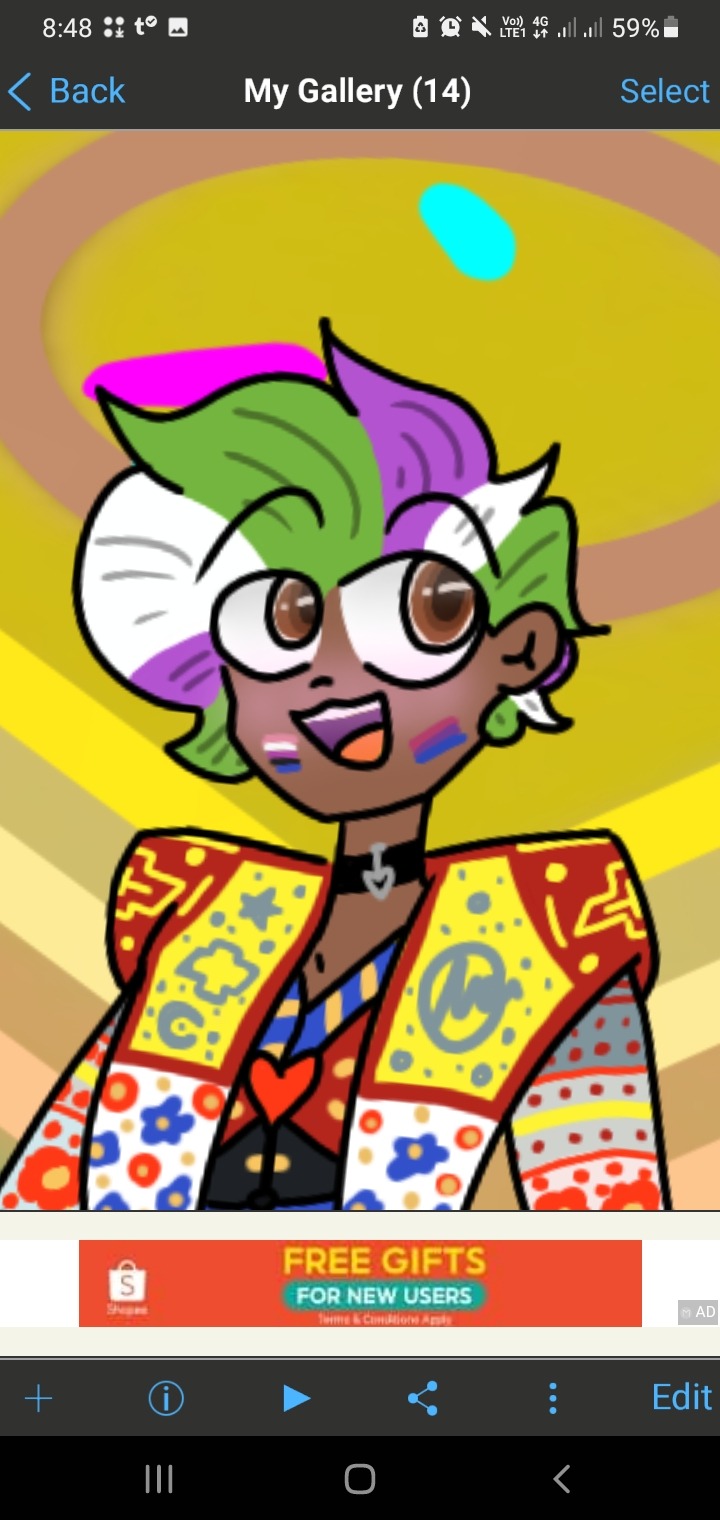
1. Camaro without the sprinkles
2. Background (I love this happy little accident)
3. PFP (I love how it looks like she's got black lipstick on!)
Ahh, anyways thank you for the ask Arc and I'm SO sorry I got it late!
5 notes
·
View notes
Text
The Home Series: Baya Mahieddine (1931 - 1988), “Baya is Queen”

Untitled, (1967)

La danse des foulards, (1975)
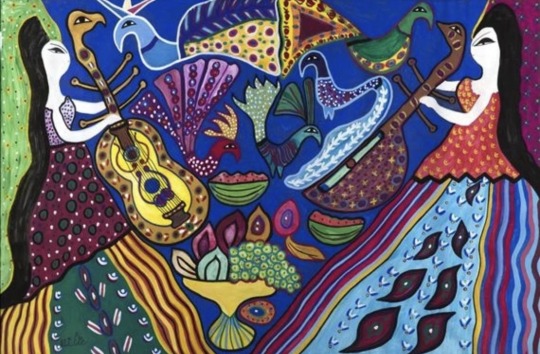
Deux musiciennes, (1969)
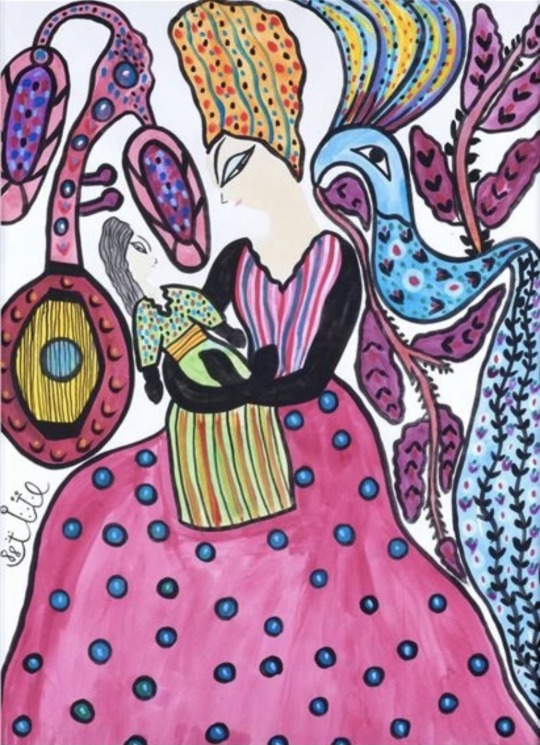
Maternité
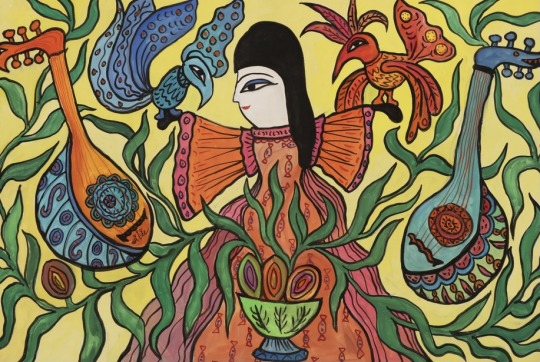
La danse (ou Femme aux instruments de musique), (1968)

Untitled, (1987)
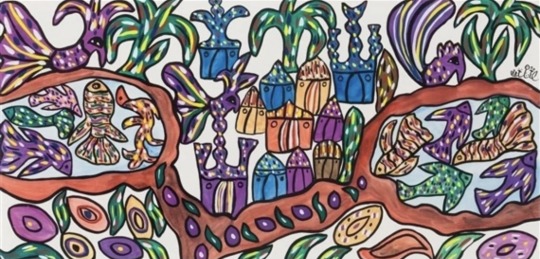
Village algérien avec fleurs et poissons, (1978)
In the ethereal sceneries Algerian surrealist queen Baya Mahieddine gives us a glimpse of, women are haven of all delicacies of this world. Bred by her rich imagination, she captures women with the same sense of delicate curiosity as birds, gardens, fruits, river flows, music instruments: heavenly. At its core, the dreams she draws are reminiscent of the divine promises that await believers in Jannah (Heaven)- which literally means Garden in Arabic. Bowls of fruits, flower bouquets, beautiful plant pots, trees, lamps, harps, lyre, zithers, violins, birds, all live through her paintings. Although her work has never been claimed to be anchored in Islamic Art, these unworldly scenes stirred from her imagination seem to be the fruit of her Algerian culture tangled with its rich Islamic tradition. Mosques fade with birds under taller palm-trees, fish wider than Touareg houses in villages inhabited by oversized peacocks... The Algiers raised artist taught herself to put imaginary dreams above realistic depiction. It comes to fruition in this artwork, reminiscent of an Earthly level of Heaven through painting.
In the blissful reveries she draws, only women peacefully coexist in dream-like scenes that inspire seamless joy, the lightness of Being. Painted through the late sixties to the eighties, she celebrates women in their purest forms: mothers, friends, dancers and musicians at turn. They seem freed of any worldly sexist burden that the artist herself has witnessed, by projecting them in an elated world where Life goes undiluted. I could almost hear the sound of Peace she paints. Mothers lovingly hold their children in intimate scenes conveying the impression that only the two of them exist. They are undisturbed, sharing these utmost precious moments of Love, safeguarded by birds and music, as if we see what’s being felt. Women are also embodiment of the delights of Life, they gather in celebration of dance, music, and sisterhood. She decorates her subjects with beautiful dark long hair like shields of protection, or sometimes wear their hair under colourful scarves worn upwards - like she did herself. The dresses they are adorned with are pieces of art themselves, brightly coloured of oranges, greens, blues, pinks and purples. Beautifying their movements, these dresses celebrate traditional patterns. Their arms open, they welcome birds and become sort of divine fantastic creatures of Peace. It’s as if through music and dance they’d reached a state of focus that throws them in this Jannah-like universe. Rhythmic melodies, dreams, movement are also instruments of deep meditation used by the Sufi mystic branch of Islam, where worshippers gather in rituals of remembrance of Allah. La danse des foulards (1975) reminisces the whirling Dervish, dancing by twirling around themselves, right hand up to the sky as a sign of devotion to Allah, the left one to their heart to signify how Love is the essence of their belief. Bahieddine’s women may reach divine Peace through these rituals of Love fertilised by music, dance and community.
She brilliantly awakens the viewer senses by gifting them the colourful perfumes of flower gardens, the sweet sound of water covered by the rhythms of stringed Andalusi instruments, and the ecstasy of feminine bodies dancing collectively. The inspiration Baya collects make sense from her cultural heritage. Fatma Haddad from her real name, was an orphan at age 5 and has been raised by her grandmother in French Algeria, where they both were working for a French farmer, whilst most children were going to school. The garden was flourishing with birds, plants and flowers, which is reflected through Baya’s work. The farmer’s sister was Marguerite Caminat, a painter that has always been supportive of Baya’s premature talent. At age 16, after being praised by Caminat’s friend - gallerist Aimé Maeght, she had already been showcasing her work in Parisian exhibitions, published in Vogue magazine and been noticed by Georges Braque, Pablo Picasso, and André Breton. She became a strong source of inspiration for their work, influencing Picasso’s use of colour and thick lines; tributed by co-founder and leader of the Surrealist movement Breton as a prime artist; and working alongside them in the ceramic studios of Vallauris. That is until she returned to Algeria for her arranged marriage with Andalusi musician El Hadj Mahfoud Mahieddine, coinciding with the premises of the Algerian war for Independence. Her painting practice is interrupted for around ten years, either to raise her children or in solidarity with the Algerian nationalists war efforts. Nonetheless, she paints again around Independence time most of her body of work, showcased in exhibitions from France to Algeria, Belgium and the Middle East.
Her husband’s music, the farm’s garden she worked in, her motherly Love, are all still living in the divine world she’s painted. To borrow Breton’s words, “Baya is queen”. She is a prime figure of a self-taught artist sharing her dreamy musings into a painted figurative proposition of her Universe. The harmonious imageries her paintbrush birthed all reflect intimate moments of calm and serenity. Baya will remain a queen of Imagination, gifting us these surreal scenes for us to wander through her body of work fed by the richness of Algerian and Islamic cultural heritage.
13 notes
·
View notes
Text
Religion & Its Sphere of Influence
‘How do you make any sense of history, art or literature without knowing the stories and iconography of your own culture and all the world’s main religions?’
- Polly Toynbee
Religion is not just about religion. It is not just about the individual. Without understanding religion, you cannot understand culture, a huge amount of history, art, the workings and rulings of a country, international relations, or even whole paradigms of thought. To begin to understand any one of these things, it must be acknowledged first that religion, faith, culture (and even languages to a degree) though are separate entities, are intertwined to create the beliefs and societies we have today.
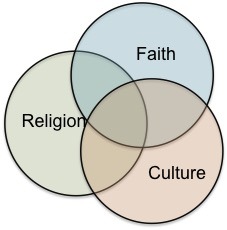
If you look at the diagram above (it took me a while to choose the colours, because colours are important, right?), I will go through the different parts and explain how they work, probably with reference to my own culture/life.
To follow a religion is not just to follow and worship a divine being, it should be understood as the system by which you have faith and worship. What I mean by system is the way in which you show/present your faith and worship, whether this be Sunday prayers, or prayers five times a day, or not eating dairy and meat in the same dish. I draw a distinction between this and faith; faith for me in not the manner in which you show or practice your belief like you do when you follow a religion, but a faith runs much deeper. It is the personal conviction that you have and the trust you put into a way of life, whether this is a God, or many Gods, or whatever you have faith in. When faith and religion come together, you have a person who puts their faith in X (say, Jesus) and lives their life according to the rules of Y (Christianity). But the difference between a religion and faith is something quite distinct.
And then we have culture. Culture is probably (in some ways) a little more complex to understand than the former two. It is comprised of not just customs, traditions, behaviours, arts etc. but also the actual ideas of a society and group of people. These cultures alter and develop over time as things move forward, as people travel and societies of people merge. The overlap between culture and religion comes where practices are adopted either from a religion into a different culture, or from a culture into a different religion. For example, Bangladeshis have taken on the Hindu practice of touching the feet of their elders as a sign of respect because Bangladesh (a predominantly Muslim country) was once a part of India (a predominantly Hindu country), and somewhere, over time, the Bangladeshi community adopted the tradition of touching feet. There is also a merging of religious practices that have been adopted by cultures of their own. For instance, in Islam, eating pork is haram (prohibited) because when the ruling was first decreed, pigs were the dirtiest animal and carried the largest number of diseases. Eating them would mean getting exceptionally unwell if not death, so the ruling was passed. Following this through to the modern day, Muslims still do not eat pork but more so because it has become a cultural norm that because God has commanded it. You do not need to be a God fearing Muslim who prays five times a day to not eat pork. It is part of culture now.
And finally we have culture and faith as a combination, this is the category that I would fall into, I believe. When asked how I identify myself in terms of religion, I normally answer that I’m a cultural Muslim. What this means for me is that I partake in all the customs of religion that have now become part of the culture such as Eid and Ramadan and I also have faith (according to the definition I provided above), but I don’t wake up at dawn to pray Fajr like the religion says one ought to. (I’m not one to say that any one way a person practices their religion or faith is superior to another and refrain from passion judgment, as I hope you will too.) Most Muslims that I know fall into this category between culture and faith.
Hopefully I have demonstrated somewhat how the three work together to create societies and traditions.
The reason I write this is because I have heard too many Atheists over the last year who argue the classic “I don’t believe in religion because science” – which doesn’t have anything wrong with it other than the obvious flaw. But too many have given no credit to religion, do not want to partake in any conversation around religion or understand the role it plays in the world. Religion is not just about the ‘afterlife’, or God first creating light.
It is easy to understand the world as being divided into groups like Muslims, Jews, Christians etc. but religion is not a cult. It is easy to understand conflict as being “they killed the Jews”, or “the Muslims attacked the US” etc. but what about scenarios where, say, the Muslims attack the Muslims? What then? If we look at the 1979 hostage taking at the Grand Mosque in Saudi Arabia, we find that this was Muslims against Muslims. But why? Because of fundamental differences in beliefs about the Mahdi and the different strands of Islam.
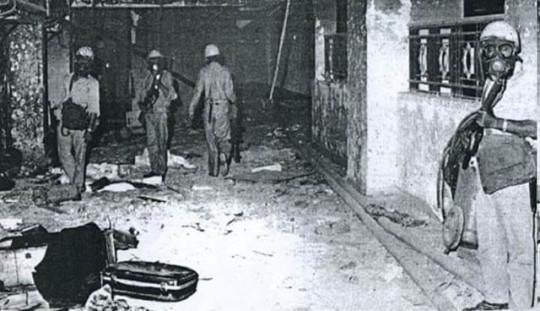
The world is a complex place and we cannot make sense of it clearly without understanding something as ingrained as religion. It is not liberal to think religion is beneath you because you believe it is an oppressive system, it is specifically illiberal to think yourself above it and pay it no heed. Atheism too, arguably, is a religion (by their definition, and faith by mine).
N.B. These opinions are not a generalisation about all Atheists, they are based specifically on vocal ones I have met over the last several months and in relation to things they have said to me. If this causes any offence to anyone, I apologise, this was not the intention.
245 notes
·
View notes
Text
SUFFERING UMMAH
PLEASE READ THE ENTIRE POST
Very important for our ummah.
By Hadhrat Moulana Abdul Hamid Saheb (Daamat Barakaatuhum)
During a trip to the United Kingdom, I gave a talk in a Masjid in London. In the vicinity of the Masjid, Jews predominantly reside.
In that talk, I mentioned that once, when Haaji Bhai Padia (Rahmatullahi ‘alayh) was travelling by air, a Jewish Rabbi was seated next to him. In conversation, the Jewish Rabbi said to Haaji Bhai Padia (Rahmatullahi ‘alayh): “We are not afraid of the Muslims today, because Allah’s help is not with them, nor with us. Today, everything is about power: The one who has more arms and more ammunition, wins. We have more, and we are more powerful. However, when the Mosques (Masaajid) of the Muslims start filling up for the Fajr prayer as the Masjids get full for the Jumu’ah prayer, we will not be able to fight the Muslims, because Allah’s help will be with them, and we can never overcome the one who is assisted by Allah.”
After this talk, a young man came to me and informed me that he is from India (or Pakistan). He said: “I go home once a year. Each time, on my return, my neighbour, who is Jew, asks me: ‘How many people are attending the Fajr prayer?’ …This is the question posed to me every time. Once, I asked him: ‘Why do you always ask me this same question?’ He said: ‘Today, we have no fear for the Muslims, but when their Masjids get full for the Fajr prayer as they do for Jumu’ah, we will not fight them as Allah’s help will be with them and we cannot fight Allah.”
Abdullah S’aud is a brother from South America, whose homeland is Palestine. He related that he was a little child when his family was exiled to South America. At that time, Ariel Sharon mentioned to the father of Abdullah S’aud: “You will come back; but not today and not tomorrow. You will come back when your Masjids are full for Fajr like how they are for Jumu’ah.”
We clamour and we shout and we cry, for the rise of Islam, yet we do not rise for the Fajr Salaah.
Our hypocrisy becomes evident in the light of the Ahadith. There is no doubt of a person’s Nifaaq (hypocrisy) if he is absent from the Fajr and Isha Salaah, in the Masjid.
Rasulullah (Sallallaahu ‘alayhi wasallam) said: “The most burdensome prayers for the hypocrites are ‘Isha and Fajr, but if they only knew what they contain, they would come even if they had to crawl.”[1]
Rasulullah (Sallallaahu ‘alayhi wasallam) said: “A person who does not go for Salaah after hearing the Azaan is committing a great wrong and is doing an act of Kufr (disbelief) and Nifaaq (hypocrisy).”[2]
Hadhrat Abdullah Ibn Mas’ud (Radhiyallahu ‘anhu) had said: “If you neglect the Sunnah, you will go astray. Verily, I have seen a time when no one stayed away from the congregational prayers except for the hypocrites who were well known for their hypocrisy or a sick man. I remember that a man would be brought leaning on two men and put in the Saff (row) to attain its reward and escape the sins of missing it.”[3]
If the entire Ummah performed Salaah - established Salaah - the entire Ummah would be in the protection of Allah Ta’ala, the One who is Al-Mighty and All-Powerful. No power on the surface of the earth will be able to overcome or defeat a people in the special protection of Allah Ta’ala.
Rasulullah (Sallallaahu ‘alayhi wasallam) said: “Whoever prays the dawn prayer (Fajr), then He is under Allah’s protection. So beware, O son of Aadam, that Allah does not call you to account for being absent from His protection for any reason.”[4]
Boycotting, sanctioning and marching may find a place in bringing attention to injustice and crippling an economy but they do not draw the assistance of Allah Ta’ala. The assistance of Allah Ta’ala comes only with obedience to Allah Ta’ala and with conforming to the Sunnah.
Muslims, today, see some kind of solution in marching and boycotting – but sadly, do not see the solution where it is: In practically implementing the teachings of the Qur’aan and Sunnah.
We will only overcome the forces of Zionism and the enemies of Islam taking the route of obedience to Allah Ta’ala and His Rasul (Sallallaahu ‘alayhi wasallam).
Our condition is that Salaah is neglected; the beautiful Sunnah is disregarded - there is no care and no concern to identify ourselves with Rasulullah (Sallallaahu 'alayhi wasallam), by adopting the Sunnah Libaas (dress/garb), maintaining the beard one fist length and following in his noble footsteps. ...The majority do not want to give up the song and dance, the interest and gambling, the western culture or the Hollywood/Bollywood culture, and all other sins. ...Then how will we invite Allah Ta’ala’s Nusrah[5], in this manner?
Allah Ta'ala has His conditions. These will have to be met first, before we can overcome our enemies.
Allah Ta’ala clearly defines His conditions and His promises:
“Allah has promised, to those among you who believe and perform righteous deeds, that He will, of surety, grant them in the land, inheritance (of power), as He granted it to those before them…
So establish Salaah (Prayer) and give regular Charity (Zakaah); and obey the Messenger that you may receive mercy. ”
[Surah Nur 24 : 55 / 56]
The Sahaba-e-Kiraam (Radhiyallahu ‘anhum) were able to overcome the super powers of their time because they were living Islam.
The keys of Masjid-e-Aqsa were willingly handed over to Hadhrat Umar (Radhiyallahu ‘anhu), the Ameerul Mu’mineen, whose reign as the Khalifa saw the establishment of justice on the face of the earth. This justice was through the implementation of the Qur’aan Sharief and Sunnah and standing firm and resolute on its teachings.
Hadhrat Umar (Radhiyallahu ‘anhu), himself, said: “We are a people whom Allah Ta’ala elevated with Islam.” – i.e. true and sincere submission to Allah Ta’ala.
We talk about Masjid-e-Aqsa and the violation and desecration of Masjid-e-Aqsa by the Israeli Zionist forces. However, the condition of Masjid-e-Aqsa is only a reflection of the condition of the Ummah at large.
Sheikh ‘Ali Abbaasi, the Imam of Masjid-e-Aqsa, had asked Hadhrat Mufti Ebrahim Salejee (Daamat Barakaatuhum), the principal of Madrasah Taleemuddeen, about the sad and distressing condition of Palestine and asked why there is no support from the Muslim countries.
Hadhrat Mufti Saheb (Daamat Barakaatuhum) explained that he had read in the Tafsier of Hadhrat Moulana Ashraf Ali Thanwi (Rahmatullahi ‘alayh) that Allah Ta’ala has different systems for Masjidul Haraam in Makkatul Mukarramah and for Masjidul Aqsa.
Hadhrat Moulana Ashraf Ali Thanwi (Rahmatullahi ‘Alayh) had explained in his Tafsier that Masjidul Haraam is continuously under the protection of Allah Ta’ala. The Kuffaar will not be able to gain control of Baitullah, and the condition of the Muslim Ummah does not affect this protection. This protection has no interruption.
The condition of Masjid-e-Aqsa is centred and based on the condition of the Muslim Ummah.
If the Ummah is obedient to Allah Ta’ala, then Masjid-e-Aqsa would be in their full control. If the Ummah is in the disobedience of Allah Ta’ala, then the Muslim Ummah loses control of Masjid-e-Aqsa and the land of Palestine. Control is handed over to our enemies.
This is what we see today. A great majority of the Muslim Ummah are heedless of the Commandments of Allah Jalla Jalaaluhu; even engaging recklessly in sins.
We raise our voices against the Israeli Zionist forces who desecrate our beloved Masjid-e-Aqsa; we march against the injustice, we wave the Palestinian flag everywhere, and we wear its colours in some way or the other - all in solidarity. ...However, if we are not performing Salaah and if, in our lives, there is disobedience to Allah Ta'ala, then let us understand the very, very sad reality: We are instrumental in the desecration and violation of Masjid-e-Aqsa and the oppression of the Palestinian people. Then our role is not constructive; rather it is destructive - because we are a contributing factor to the Israelis having control of Masjid-e-Aqsa.
Imam Maalik (Rahmatullahi 'alayh) had said so aptly, in his time: "The last generations of the Ummah can only be reformed by that which reformed its first generations. What was not part of the religion then, cannot become part of the religion now."
The first step is establishing Salaah in our lives and working towards bringing the whole of Islam into our lives, practically. If we really want to solve our problems, this is the only way.
May Allah Ta’ala forgive us, have mercy upon us, guide us, and grant us the understanding and the Taufeeq of becoming practical on Deen.
http://hameediyyah.blogspot.com/2014/10/deliverance-for-suffering-ummah-gateway.html?m=1
#palestine#free palestine#palestine lives matter#palestinian lives matter#palestinians#allahuakbar#onpoint#alhamdulliah#subhanallah#islamdaily#islamicpost#muslim#masjid al aqsa#kabah#fajr#fajrprayer#jummahfriday#jummahreminders#ummah#muslim ummah#one ummah
13 notes
·
View notes
Video
youtube
Masjid Al Aqsa Pencil Drawing Easy Step by Step
It's a tribute to Masjid Al Aqsa pencil drawing easy and step by step. Learn the real Masjid Al Aqsa drawing easily with colour from this drawing tutorial. We all know about the second Kaaba of Muslim Ummah, so it is significant to Muslim communities all over the world. Love you Al Aqsa from my heart, as Millions of Muslim people died because of this holy place due to the aggression of Zionism. We all know this aggression will stop one day and the day is very near. So we should pray to Allah to save the holy land Palestine from aggression as well as destroy those oppressors and clean the world. We are still optimistic Allah will grant millions of people dua InshaAllah..
🛡️ LIKE ✅ COMMENT ❇ SHARE✅ SUBSCRIBE 🛡️
✅꧁𝓢𝓾𝓫𝓼𝓬𝓻𝓲𝓫𝓮: https://www.youtube.com/c/FarinKhanArtAcademy
📌 Pinterest: https://www.pinterest.com/farinkhan2007
📌 Facebook: https://fb.me/HowToDrawingTutorialForKids
📌 Twitter: https://twitter.com/sweetdhaka
📌 Instagram: https://www.instagram.com/farinkhan2007
#alaqsa #alaqsamosque #alaqsapalestine #alaqsamasjid #alaqsacompound
#youtube#al aqsa drawing easy#al aqsa drawing#masjid al aqsa drawing step by step#real masjid al aqsa drawing easy#real masjid al aqsa drawing#al aqsa mosque drawing easy#masjid al aqsa drawing colour#al aqsa mosque drawing#how to draw#drawing#drawing for beginners
1 note
·
View note
Photo

Oh for a Jacinda Ardern level of leadership in the UK. Not only was she fantastically respectful and proactive after the Christchurch mosque massacre in March 2019, but now she’s encouraging people to hold a nationwide Easter egg hunt (within isolation lockdown limits) for the children. How fantastic is that?
[Insta message reads:
This is a message for the kids of New Zealand. I’ve been asked by lots of you whether the Tooth Fairy and the Easter Bunny are an essential service (I even got asked in a press conference today!) I have good news, the are! But because we’re all in isolation at the moment, the Easter Bunny might not make it to every house this year (they probably have to look after their own Bunny family too). So just in case, I’m wondering if you’ll help me create an Easter egg hunt for all the children in your neighbourhood? You can draw your own Easter egg, or you can colour in the one that some of my clever friends helped to make. All you have to do is colour it in or decorate it, and pop it in your window for other kids to find. I'd also love to see your designs. If you email them to [email protected], or share them on social media using the hashtag #NZEggHunt, I'll pop a few of them here and on Facebook over the Easter weekend. Have fun everyone! P.S you can print a copy of this colouring sheet over on my Facebook page.]
Meanwhile, our own leader is a racist, homophobic and misogynistic piece of shit who lies and lies, and then lies some more when he’s caught out. A total waste of space.
2 notes
·
View notes
Text

1. Indonesia, summer
Summary: She writes for magazines about luxurious resorts in exotic places and five-star hotels in glamorous cities. He’s photographed devastated war zones, refugee camps and child soldiers. For both of them travel is an escape, but he’s had enough of this grim reality, and she’s had enough of this disconnected fantasy. Perhaps together they can find something in between, something real, and stop running from themselves. Each season, a new destination and a chance to grow closer.
Pairing: Alec Hardy x Hannah Baxter Rating: Mature~ish (for now) Word count: 3.9k
A/N: Thank you to @onthedriftinthetardis for sharing her insights on being a photographer. Chapters are named after airport codes.
Prologue | Ao3 | Gifset

The large, multi-level pool stops just short of a rocky cliff that dips into the Indian ocean, but the turquoise shade of the chlorinated water creates a nearly seamless continuity. Only the white froth of the waves breaks the illusion. Soak up the sun and let your mind wander beyond the horizon.
Hannah dotted her sentence and flipped back through her notebook. She placed a check mark next to “pool” in her list of resort services and amenities to review.
Soaking up the sun and letting her mind wander wasn’t something she had time to do. This was actually her first time lounging by the pool and even now she couldn’t let herself go, couldn’t just close her eyes and enjoy the warmth on her skin. Her brain noticed every detail and translated them into sentences for her article.
In her job, she often did in one day what others did in three. In the last four days, she had tested the Aquatonic seawater therapeutic pool, four of the five restaurants, the art gallery and shopping arcade, the yoga class, the Canang Ketupat demonstration, the Balinese dancing course, the cycling tour, the sailboat tour and the Segway tour. All the while looking into the eco-tourism aspect of things, she’d noticed the solar panels and the reusable straws in drink, but she wanted to dig deeper. She still had to check on the botanical garden, the activities for kids, the cooking school, the gym, the martini bar, ballrooms and, worse of all, the golf course. Only three days left to do all that.
Perhaps it was time to check out the rooftop bar as well.
A young man worked under the hut-like awning of the bar. He spoke basic English. As he prepared her cocktail, she chatted with him, asking about the band on his t-shirt and his hobbies. But soon, her gaze drifted away from the bartender and the beautiful beach vista, to the island itself, beyond the resort. Too far off for details, it appeared as a chaotic array of colourful houses under palm trees, quivering in the heat like a mirage. The Mahal Kita resort was nothing short of paradise, but her feet itched to explore the rest of the island.
She asked the bartender for recommendations, but he only mentioned activities offered by the resort. When Hannah insisted she wanted to see the town, he laughed, something she’d learned meant “no” here. She questioned him further and found out he wasn’t even from Pulau Kesuma and neither were his nearest coworkers. The employees lived in a dormitory on the premise and left the island on their days off.
As nicely as possible, Hannah insisted to speak to a local person to answer her questions. At last, a maid was waved over. She drew a crude map of the town with indications to the market and a beach. When she expanded her drawing to the west side of the island, the bartender stopped her with such vehemence that both Hannah and the maid started.
“No, no. No west. Dangerous,” he said.
The two Indonesian exchanged a cold glance Hannah couldn’t decipher.
“Okay, then I’ll be careful. Thank you…” She eyed their name tags. “Budi and Alya.” She tipped them both generously.
The hotel’s main entrance opened directly on the jetty where the ferry from Jakarta docked. With water on either side, there was nowhere else to go, so Hannah spent a good twenty minutes looking for another exit leading to the town.
“This is ridiculous,” she muttered to herself.
All the service doors required I.D. cards. Finally, she spotted a kitchen helper and asked him for a light for her cigarette, she offered him one in exchange. She’d found it was always a good way to strike up a conversation with a stranger in a foreign country. Or, in this case, to ask for a favour. The kitchen helper opened a service door and they sneaked out of the hotel.
Hannah felt like Alice stepping through the looking glass. Out of the conditioned and, she now realized, perfumed air of the resort, heat and a hundred scents assailed her: dusty earth, petrol from the old motorbikes used by the locals, and the sweet green fragrance of flowers that gave the island its name, Kesuma. A goat bleated. A bike zoomed past her. And wanderlust stirred butterflies in her stomach.
She donned a large, floppy sun hat and set out to explore new grounds.
*
“Let me the hell out of here,” Hardy said to a security guard.
Five minutes and he had already run out of patience with this place. Jet lag stretched like a tight rubber band around his head. He had a meeting in town with Ellie and her partner, but couldn’t figure out how to get out of the hotel.
He’d arrived late last night, and the ferry took him straight to the resort. Aware of the scam, he hated giving the resort his money, but he had to be inside to investigate.
The security guard let him out a service door and vaguely indicated the direction of the market.
Hardy walked fast. His previous trips to other parts of Indonesia and Ellie’s instructions helped him navigate the unknown town.
The messenger bag holding his camera equipment bumped against his hip with every step, a sensation he’d grown accustomed to. Camera in hands, he was on the lookout for signs of the tourism industry already affecting the local population. On a street corner, a young woman, barely able to meet his eyes, lowered her dress and bra strap. Anger boiled in his stomach. He averted his eyes.
Along the way, he snapped pictures, almost aimlessly: crumbling houses, drunk men, working children. None of it exactly what he needed.
He knew he’d found what he he’d been looking for when he saw it: fishing gear propped against a wall. The composition was perfect: the sun shone on the shiny reels and the hooks dug into dry, cracked soil. The contrast between the fairly new equipment and the dust and spider webs covering it told a story of wasted potential. He took many pictures from different angles.
*
Hannah made her way toward the market as best as she could given the lack of street signs. She turned onto an unpaved narrow street. Small wooden houses crouched between tall palm trees and laundry hung to dry above her head. Women squatted in front of small brick fire places, cooking on a grill set directly over the flames. Chicken pecked around them. Bare-feet children, with dry snot under their noses, played with rusty bottle caps.
It reminded her of a trip to Thailand four years ago. She was no less shocked, and yet fascinated, that people still lived like that. But this time, the nearness of a luxurious resort accentuated her discomfort. And Hannah thought she’d rather be in Europe or North America where poverty wasn’t so confronting.
She felt the eyes of every local on her, they weren’t used to tourists yet. She had only seen one other white person, a weird bloke taking multiple pictures of fishing rods. Some children hid behind their mothers, others called her “Bule!” a slang word for white foreigner. But she never felt threatened or shunned, most people she came across smiled at her in the friendliest manner. She returned the greetings but didn’t engage further. There was always that push and pull within her, between keeping her distance from people and yet wanting to know them.
A girl of about nine with fierce dark eyes and braids approached her and touched her arm. Hannah smiled though she was ambivalent. She wasn’t naturally drawn to children but it would make cute pictures and a good story for her blog. As soon as the thought crossed her mind, Hannah resented it.
“Where can I eat?” Hannah asked the child, miming the action.
Instantly, other children came to her, five of them, with dimpled cheeks and second-hand superhero t-shirts. They all giggled. The eldest little girl, the one who had approached her first, whistled loudly and they all followed her. Hannah had no idea where they were taking her.
Shrubs lined the street and a little boy picked a fruit and handed it to her. It was a small, pinkish ball with green hair. She scrunched up her nose at it and waited until the children had eaten theirs to make sure it wasn’t a joke. A boy, no more than seven, took a knife out of his pocket and expertly sliced open the fruit for her. Inside was a milky white ball, similar to lychees. As she tasted the fruit, her brain looked for the right words to describe the refreshing, mild sweetness of it to her readers.
The children gave her more fruits, and she thanked them in Indonesian, “Terima kasih.”
“Rambutan,” he said.
“Rambutan?” she repeated.
He pulled on his black hair, “rambut,” he said. Then on the hair of the fruits, “rambutan.”
She snapped some photos of them and the fruits with her mobile phone. They all pressed around her, wanting to see the result on the screen. The photoshoot lasted longer than she’d intended. An adult passing by yelled something along the line of “stop pestering her”, and the kids scampered away. All of them except the little girl that had first approached her. In fact, she looked unimpressed by the adult. Hannah felt she’d found a kindred spirit in this kid.
They reached a sort of town square, with a mosque and a park where a group of men had gathered. A tin roof held up by hand-carved columns housed the market place. Hannah marveled at… everything. Behind makeshift stalls, men shouted prices for rice noodles and fruits. On the ground, large, shallow baskets displayed grains and legumes. An eyeless pig face, hung like a mask above a meat stand. Underneath, a bored woman wearing a headscarf chased flies away with a palm leaf.
The whole place was alive with chatter but a tension brewed underneath. Something was amiss.
Hannah wanted to go inside the market, but the little girl guided her elsewhere.
On a street corner, many local people queued. Before them, an old woman, at least eighty years old, hunched-back and sun-spotted, served food to them. Old, misshapen pans and plastic buckets surrounded her. Her knobbly hands efficiently wielded a string to slice through a green, cylindrical fruit. She then dropped handfuls of shredded coconut, balls of sesame seeds, and what looked like tiny pancakes onto a folded banana leaf. She covered carelessly the whole thing with a ladleful of brown syrup. It looked nothing like the “authentic and locally-sourced” food served at the hotel. And it was certainly less hygienic. But the scents— and her own sense of adventure— were too enticing to resist. She’ll try anything once.
*
Hardy spotted Ellie across the road, waving at him to come over. Her youngest son was with her.
“Hiya! Sorry for making you walk all the way here, we’re not allowed near the resort anymore.”
She gave him that grin of hers, with her small upper teeth pushing forward.
They’d first worked closely together in Bangladesh, after a sweatshop collapsed and killed over one thousand workers. She was a journalist for BBC World. It was her first time covering such a tragedy. Despite a rocky start, they’d developed something like a friendship, but it was hard to keep in touch when they both worked around the world. Last he’d heard of her, her husband had been arrested for murder
“You look well,” Hardy said.
It was an understatement. Her hair had grown, and her loose white linen shirt accentuated the healthy bronze glow of her skin. She seemed happier than he expected given the circumstances.
Beside Ellie stood a short man with a young, russet face, smooth skin safe for a little patch of hair under his bottom lip. He wore a suit despite the heat. He shook Hardy’s hand with nervous enthusiasm and introduced himself as Kadek Suardika Rahi.
They sat on the terrace of a restaurant. An outsider wouldn’t know this was a place of business: a dozen makeshift stools under an awning made from old vinyl advertising banners. In the heat, a rubber-y scent emanated from it.
Hardy was eager to learn more about the scandalous practices of the Mahal Kita Resort, but cultural norms demanded a beverage and small talk first. He opted for a cold drink made with coconut milk rather than the local variation on Java coffee.
“I met Kadek when I was covering the tsunami,” Ellie explained. “He was a doctor in England, but when he saw what was happening in his country, he decided to come back and help his people.”
“And Ellie helped make sure the natural disaster was not forgotten by the international community.”
They shared a smile and so much seemed to pass between them, reminiscence and adoration. And Hardy was surprised to feel a pinch in his heart, a longing for that kind of intimate language without words.
Hardy cleared his throat, suddenly uncomfortable. “So you live here now?”
“Not on Pulau Kesuma, no, not all the time. We live in Jakarta. Tom attends an international school there. Kadek’s whole family is here, though.”
She’d quit her job and now taught journalism at the university on top of helping local newspapers and free speech organizations.
“How’s your daughter?” Ellie asked.
“She’ll start uni next fall.”
He skimmed over the strained relationship with Daisy. He’d taken all the blame for the divorce, and rightly so, he had been away too often. His daughter had once accused him of caring more about children in Africa than about her.
A flash of blond hair and pale skin caught his eye. He scoffed at a young woman in too short shorts and a large hat. She didn’t even notice her selfie stick was in the way of a man and his cow. “Parasite,” he muttered. As far as he was concerned, these tourists were as guilty as the corporation who owned the resort. They should educate themselves and stop encouraging unethical tourism.
Kadek related to him what he’d heard from his family and other local residents. While the people were still struggling with the physical and psychological damage of the tsunami, foreign investors took advantage of the chaos to seize the land. Masked men, armed with machine guns, forcefully evicted the families. They built an electric fence around 400 acres of land. The land acquisition extended into adjoining bodies of water thus denying access to fishing grounds.
“It’s not just about the loss of income,” Kadek insisted, “we are a fishing people. This is our traditional way of life. Now we can be charged with illegal trespassing! On our own land!”
“What about the government?” Hardy asked though he had little illusion as to their role in this.
“The Navy helped the foreign investors,” Ellie answered. “At first we thought it was just a small part of the Navy gone rogue for profit. But when we petitioned the authorities for help we were shut down. They’re bloody shareholders.”
“Ellie received threats after she wrote about it in the Jakarta Post,” Kadek added, putting a protective arm around her shoulders.
The blatant abuse of power made Hardy’s skin crawl.
“Do you have any proof of all this?” he asked.
“Only what people told us. The security guards at the resort know us. We can’t go anywhere near. They don’t like us sniffing around. That’s why we need you.”
Hardy, Ellie and Kadek spent the afternoon touring the island. They talked to evicted families and angry fishermen. Hardy documented the destruction, but the resort people were good at covering their tracks, most of it could be chalked up to the tsunami.
One thing that kept coming back was talk of discolored water that poisoned the mangrove, dead fish drifted to the village like bad omens. No one knew where it was coming from, but a portion of the west side was completely off limits, enclosed by an electric fence and guarded by armed men. Hardy couldn’t risk antagonizing them. Not yet, at least.
He ate supper with Kadek’s parents who welcomed him like a member of the family. He admired how Ellie had adapted and built a new life, a new family, for herself.
When the sun started to set, he left the Rahi family with a promise to help. Wherever he went, he met people who had almost nothing yet demonstrated such generosity. It both soothed him and stoked his drive for justice. And so, he headed back to the hotel to investigate under the cover of darkness.
*
Hannah stepped out of the shower and grabbed the complimentary bathrobe. She noticed its softness. One look at the tag informed her it was made of organic bamboo fibers. She made a mental note to mention it in her article along with the nice mango shower gel that now perfumed the steamy bathroom. These were important details. Her readers expected to learn everything about a hotel, including the quality of the clientele which is why there was a German man in her bedroom. Presently, she caught him hastily pulling up his trousers to sneak out. Shame passed quickly over his handsome face.
“Maybe we can get a drink tomorrow night?” he said.
“Yeah, maybe.”
She was relieved he was leaving on his own so she wouldn’t have to get rid of him with increasingly unsubtle hints. It occurred to her after that he might be here with his wife and family.
She closed the door behind him and fell back on the bed. The room had a high, peaked ceiling made of dark wood and the dim light didn’t reach all the way up it. It looked like a void opening above her, growing as the evening turned darker.
Hannah reached for her phone. She sent Ben a text message, but doubted he would answer; he was sulking. She turned to social media. She posted a picture of the food bought in the market asking “what is this?”. She added a line about the cooking class she would take tomorrow and tagged the resort. Notifications popped up, but somehow only added to the oppressing emptiness growing in her chest. She dismissed the feeling as nothing more than her unsatisfactory hook up. The man had a nice body that promised more pleasure than it had delivered, leaving her keyed up.
Her hand ventured between her thighs. There was nothing but the sea outside her open windows, so she discarded the bathrobe, let the warm night air caress her body and set out to finish what that man had started.
“Hmm, much better,” she sighed after.
She cleaned up and wrapped a long sarong under her arms. Time to get back to work.
With her trusty Moleskin notebook in hand, she sat on the doorstep. A couple of rooms to her left, people were laughing and splashing around, but the sound of the surf, just a few meters ahead, interested her more.
Her pen moved fluidly across the paper, and she found herself writing about that little girl and the old woman serving food. She wondered about their paths in life, about one’s past and the other’s future. How different they were from her own life. She knew none of it would make it into her article, Elite Travelers wasn’t interested in that, but she felt compelled to put her complex feelings into words.
A flash of light disturbed her focus, followed by shutter sounds. She jerked up and squinted through the darkness.
In the bushes, a man was taking pictures of her. How long had he been there? Had he seen her masturbate?
“What the fuck are you doing?”
The man ignored her and kept taking pictures.
“Oi! Stop that, you perv!”
“Wha’? Get back in your room, ma’am.”
She hadn’t expected to hear a Scottish accent. He stepped closer, into the pool of light from her room. She recognized him from earlier in the village.
“Are you stalking me?” He looked at her like she was nuts. “Go away or I’ll call security.”
“Just get back inside. I’m a photojournalist.”
“What? For Playboy? Go. Away.”
“I can’t, I need—”
“That’s it, I’m calling security.” She turned to head back inside her room.
“For god’s sake. Wait!” He climbed the steps up to her. “The hotel management can’t know about this… I’m investigating the resort. Look.”
He showed her the pictures he’d taken: foundations and more brick work, the beach and swamps, portraits of local people. None of her. It was a relief (although having a stalker would be kind of flattering).
She took a good look at him: with his canvas shirt, sleeves rolled up, and scruffy cheeks, he looked overworked rather like a relaxed tourist. There was something about his stance, the hands on his hips, the unwavering gaze on her, an air of detached authority that made her trust him.
“Alright.”
“Good. So, you get back in there and let me do my work,” he said.
“Hold on, I’m a journalist too.”
He quirked an eyebrow, skeptically.
“I am. What are you investigating?”
With more probing—and threatening— he revealed, in vague terms, he was interested in the environmental impacts of the resort.
“What about what’s going on the west side of the island?” she asked.
He perked up at this— as much as this man could perk up. “You’ve seen something?”
“Well, I went sailboating— ”
He scoffed.
“What’s wrong with sailboats?”
“Local fishermen were banned from their own ancestral fishing grounds so you could go on a bloody sailboat. That’s what’s wrong with it.”
The accusation stung. Hannah took a step back. “And that’s my fault, is it? You know, sharks almost went extinct here because of the fishermen.”
He didn’t reply, though she had the feeling it wasn’t because she’d won the argument. He obviously knew more than he let on. As annoying as he was, she wanted to know more too.
She invited him in her room, to show him something she’d discovered on her photos. During the sailing excursion, Hannah had spotted what seemed like a lovely secluded beach. However, when she asked about it to the captain, he immediately veered the boat away. That beach was on the west side of the island, the one she’d been warned against this morning.
She handed him her phone, but he frowned at the selfie displayed.
“No, look closer, you muppet, in the background.”
She zoomed in. There was a high fence, partly covered with vegetation, and what looked almost like a bunker.
“Maybe there’s another way in,” the photographer mumbled. “There are rumors about— oh...”
He’d swiped too far and reached a picture of Hannah in a rather revealing bikini. She tittered at his blush. He shoved the phone back in her hands with a scowl. He considered her for a moment. His sharp gaze openly scanned her, and Hannah became very aware that she was wearing only a sarong.
“Alright,” he said, having come to some conclusion. “Could you take me there?”
“Yes,” she replied with more confidence than she felt.
Hannah went to the bathroom to put on a pair of shorts and a white t-shirt. She felt like she’d drank too much coffee. She was excited by the secretive nature of the investigation and the shared complicity with this photographer.
She slipped her phone and keycard in her back pockets, and they headed out through the patio door.
“I’m Hannah Baxter, by the way.”
“Hardy.” They shook hands. “C’mon, Baxter, stop withering.”
#
Chapter 2: Indonesia, summer (cont’d)
A/N: Pulau Kesuma is a fictional place but what happened there after the tsunami is based on real events that took place in Sri Lanka.
#Hardy x Hannah#teninchfic#Broadchurch#secret diary of a call girl#Did I mention this is a slow burn?#lostinfic writes stuff#travelers AU
32 notes
·
View notes
Text
Whalebone & Crabshell - Repost
Context: this story, “Whalebone & Crabshell”, was written around the time of the 2015 Rohingya refugee crisis.
It was first published on Projek Dialog. Then it was performed on BFM89.9. Then it was published again in Dark Mountain: Issue 9.
Since Projek Dialog has gone through a redesign, obliterating the story’s paragraphing on that website, I’m re-posting “Whalebone & Crabshell” here, in full. Illustrations by Sharon Chin.
+
WHALEBONE & CRABSHELL by Zedeck Siew, with illustrations by Sharon Chin
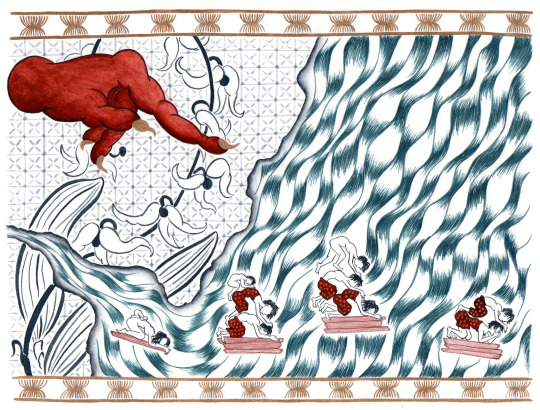
This is how our land is laid:
Firstly, the domains of the Sultan -- may God ever extend his years -- the groves and fertile paddy-lands; the ports and isles and cities, where spice is sold and timber traded; mosques full of devotees; loyal citizens talking in civilised tongues.
O our Sultan, may he reign safe upon the throne!
And then, the sea, full of bounty -- but also of pirates, submerged giants, ghosts of wind and water; playground of the Lordly Dragon, and the great spirit Root-of-Creation, who lives in the navel of the ocean --
O grand Mother Ocean, who is female, therefore occasionally chained but never tamed.
And then there are the inlands and the uplands: in the jungle interior, upriver, full of hidden primates and uncivilised peoples.
Indeed, to be an inlander is to live lawlessly, as a fugitive from the Sultan's justice -- and uplanders are all revolutionaries and deviants anyway; they practice schismatic rites and prostrate themselves before idols.
O God save us!
#
Our Sultan -- God save him -- in his thirty-third year, having crushed the rebellion of his admirals, decided to demonstrate his piety by bringing order to all benighted places.
Thus the headwaters were choked with barges, and armies bore into the forest deeps.
The hillside crops burned, the hillfolk bandits were slaughtered; the hidden valleys echoed with the screams of women and dying mercy-cries in throat-some languages.
Finally all the hinterlands were pacified, and the inlanders captured; disarmed; rounded up; assembled together in a great field, where they knelt of their own accord, awestruck and shivering at the sight of the Sultan’s yellow-gold pavilion.
So the Sultan turned to his advisors, saying: “O wise councillors, grant me your wisdom, in turn granted by God! What should be done with this rabble?”
#
And the Admiral, with his sickle-spear, said:
“Slay them down to the youngest son, no mercy should be shown. Only then can we be sure!”
But the Treasurer, with his pen and parchment, said:
“There are a thousand families, times seven members on average, times five minutes per execution at the quickest, also accounting for the number of axes dulled, good trees felled to provide stakes, pints of blood that will poison the soil -- no, my Sultan! It costs too much!”
So the Vizier, whispering into the Sultan’s ear, said:
“Exile these people, drive them to the sea / they will drown quickly!
“What better fate for squatters, thieves who stole the interior / territories by right your patrimony?”
“Oh yes sir, I’ve got a curse for that,” said the Holy Sorcerer. “They’ll never come back, sir, they’ll never set foot on dry earth again. It’s a simple spell.”
#
Therefore the Sultan -- God bless him with wisdom -- commanded eviction.
And the traitors were given the rotting planks of their dissembled hovels, to use as rafts, and they were banished down the river, through the delta, and off and out to the open water.
Some, swimming back to shore, found the tide turned against them; the harder they paddled, the farther the coast receded. Soon they tired, unable to fight the Sorcerer’s magical decree.
And thus floated -- tossed to and fro, a flotilla of sorry creatures, forsaken by both men and God.
At first there was a storm. Torrential rain beating the waves down; thunder and flashing; they were soaked to the bone, and to the bones of their boats also. Many drowned.
Afterwards they drifted. Becalmed for many days, their sweat dried into salt on their arms -- a meagre wealth, salt without rice; they were rich only with hunger, and thirst, and heatstroke; filth and illness.
Their shamans called for succour. But their idols were abandoned in the mountains, and too distant to hear.
#
Between them all there were nine coils of cord, and a single hook, previously used to fish in streams -- and its owner, sensing his importance, said:
“With my hook I will catch food. Hey, if you will owe me your lives, I should be leader!”
But the man was mostly a catfisher; his skills did not apply where they were; anyway there were only beads and loose goose-feathers to use as bait. So he caught nothing.
And during the night the some ruffians came. They stabbed him with splintered stakes; in the morning they said: “We have the fishhook. Therefore: we should be leaders.”
“Ho, hear us!” they said. “Our plan: segregation. Families first. Ours. And also: all who we see are strong. The weak: they should be sacrificed. We eat the meat off their limbs. Survival for the fittest!”
Naturally, the others were dismayed. “Abomination!” the wise-women said. Together they flung the murderers bodily overboard.
#
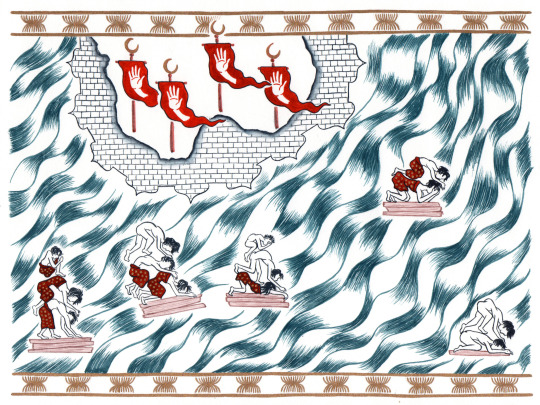
Then they came to an island of pirates.
And the pirates -- dashing though misguided warriors, their costumes tied with red ribbons, their belts studded with sea-ivory – said:
“These souls, fleeing the Sultan’s cruelty, sadly they cannot live with us. To live a life of piratical liberty, one must have sea-worth, able to court and cower before Mother Ocean.”
“In their souls they are uplanders. They have hill-shaped hearts. They can neither read star-charts nor savour the taste of spray. They’re simply not made that way!”
Having justified themselves, the pirates of the island prepared a care package -- a barrel of beer; a netful of fish; twelve blankets, folded, lowered by crane onto the outcasts’ largest raft. Along with a letter, saying:
“Ho there travellers! Unfortunately, you may not settle here. Sorry! Have these gifts, no strings attached, with our sympathies, and this whale-bone recorder,”
-- at which point a flute fell out of the unfolded page --
“with which you might use to attract a dragon-spirit’s pity. Hopefully! Thank you. Please go.”
#
Past the island there was another storm, worse than the first.
By now their vessels were broken, their drink-barrel empty; fish all gone; their blankets torn apart by fighting.
With the lightning, some clambered onto their wives’ backs -- and stretching their arms up, ate quick ends by electricity. Others, less lucky, fell into the foam -- these were dragged under. Unable to swim, too weak to struggle, they drank their deaths slower.
Among those who remained, their last wise-woman was angry at the world and everything in it.
Putting the bone flute to her lips, she stood with her back straight; her feet, each on a different log; a single note was what she played:
Shrill, clear as a horn, louder than thunderous hammer-sounds.
And she sang: “O lords of wind and water, heartless creatures! Torture us no longer! Take our lives, let us die, we offer ourselves! A sacrifice! We do not ask for mercy. Vengeance only!”
There was no human reply -- but a rumbling answer. An inhuman growl, a surging tremor from under-sea.
#
A sphere burst the surface: the size of a moon; black and smooth -- not round, ovoid now, and mounted on a tower the colour of cream.
An eyestalk, looking down.
And another. And then claws: rising west and east, each pincer-point a mountain, big and blurry with distance.
It was he who is called Root-of-Creation -- old spirit, eldest of spawn -- who'd heard the shaman’s summons. He is father of crabs, and all crabs come from him; he is the largest. Moving in the depths, his great weight makes the sea levels rise, and the tides.
The exiles, witness to such a fearful sight, cowered in terror; and even their shaman, the brave, foolish woman -- she waited there, expecting to be swallowed.
Root-of-Creation held still for a while. The curve of his shell is the breadth of continents; and inasmuch as a country could look thoughtful, he took his time to deliberate.
And, having decided, he picked them up, all of them, and he placed them upon his back.
#
Back to the first, to the Sultan’s domains -- in the ports, in the cities, there were many whispers:
That a great wave was coming; that it had wiped out the pirate-isles; that the far villages were swept away by flying swordfish, and merchant ships by constrictor-eels; that the mermaids were gone, strangled.
And bird- and gull-flocks were seen flapping over the palace. They were fleeing. The Treasurer, with his abacus, his feet soaked in salt-water, tallied costs --
“A thousand families with no homes, times seven members on average, times two silver pieces per head, bearing in mind the twenty warehouses damaged, the dozen docks destroyed, plus fifteen galleys shattered beyond repair.”
The Admiral was not at court; the Vizier’s mansion was found vacant. Both had sought asylum in an enemy state.
The Holy Sorcerer, water up to his waist, said:
“I’ve got nothing, sir. Have you seen the size of that thing? That’s Root-of-Creation, the crab-god, he’s a top-level creature. Sir, none of my spells are anywhere near his tier.”
#
Therefore our Sultan -- may God grant him speed to save his own skin -- ordered for the capital to empty.
And the citizenry obeyed, going bare-breasted through the flood; on their heads they carried babies, wicker-basketfuls of brass pieces, precious embroidery; they sat on floating bed-frames, paddling with hoes and ladles.
But at the city gates traffic slowed and halted, for the palanquins of noble families took priority. So there was a crush, a panicked clamour.
O God save us!
In the portside districts, those few still left to see saw the surf draw away. By the piers, the long-ships settled at the bottom of the bay, and listed. And behind them, in the distance, inexorably approaching:
Grand Mother Ocean, fashioned into a wall, many leagues wide and some leagues tall --
Her insides darkened by some shadow, monstrous and crustacean; crowned with froth, topped with wreckage, ridden by rejoicing figures --
Those terrible people, those uplanders! All criminals, wretched heathens, spiteful by nature; with feet cursed never to touch earth again -- regaining their hillside homelands by drowning them, offering all lands to the sea.
They have betrayed us! O God have mercy!
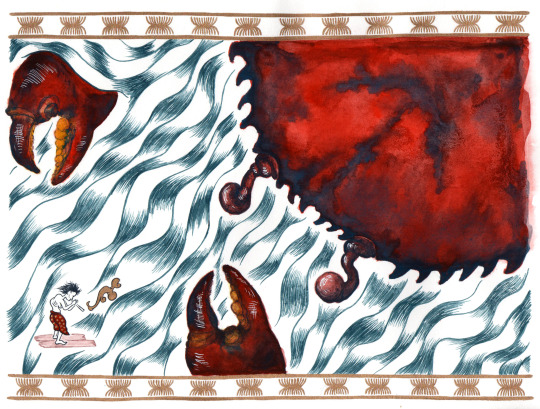
+++
This author’s note ran with the story, in Dark Mountain:
In 2015 the Rohingya people – described as one of the most persecuted minorities on Earth – fled Burmese oppression en masse, on boats. But the neighbouring governments of Malaysia, Indonesia and Thailand vacillated. The owners of those boats were human traffickers. And these countries had no space left for refugees, of course. Of course.
So the Rohingya starved at sea. Malaysian citizens took to social media to express outrage at the unfolding humanitarian crisis. ‘How could we let this happen?’ But there was little action, and attention soon petered out.
I wrote Whalebone & Crabshell under a blanket of shame. It is not a story about the Rohingya. It is a story about me: how the reality of the Rohingya makes me feel powerless; how people like me – citizens of nation-states – tacitly condone and perpetuate the conditions that turn people into displaced persons.
The Rohingya are still trying to leave Burma. They are still dying: on boats, in jungle camps, in detention centres. But news about them doesn’t make headlines any more.
And these captions, alongside Sharon’s images:
1. The floral motif decorating the landmass in the first picture is a Thazin orchid, royal flower of Burma. The most prized come from mountains in Rakhine state, on the west of Burma bordering Bangladesh, which is also the traditional home of the Rohingya people.
2. The gilt borders feature the ASEAN (Association of Southeast Asian Nations) emblem, where "stalks of padi in the centre of the Emblem represent the dream of ASEAN’s Founding Fathers [sic] for an ASEAN comprising all the countries in Southeast Asia, bound together in friendship and solidarity".
3. The crab god of the text is inspired by a Malay myth recorded in Skeat's "Malay Magic". The Pusat Tasek is a massive hole in the oceans' bottom. A gigantic crab dwells therein. It periodically leaves its home, and the volume of water its movements displace causes the rise and fall of the tides.
#fantasies#writing#fiction#published#art#sharon chin#whalebone & crabshell#seas#monsters#uplanders#gods
6 notes
·
View notes
Quote
Here is a major reason why I am not a ‘leftist’. Ask Western 'leftists’ what they think about the compulsory hijab laws in Iran. It saddens me how so many of them seem to be unable to outrightly condemn the law without any reservation whatsoever. Frighteningly enough, many of them will be very evasive in answering that question. They’ll assume that one’s reasons for opposing compulsory hijab laws in Iran can never be sincere. That the only reason one could possibly have for caring is because they wish to draw attention away from authoritarian laws in the West. That, to me, is very discouraging. Sadly, some 'leftists’ will even provide this following answer: 'It’s their country. They can establish whatever laws they like.’ *shakes head in dismay* Well, gee, that gives me so much comfort. It provides a lot of comfort to me, a black person who grew up in the Jim Crow South, to know that a lot of 'leftists’ will prioritize 'cultural rights’ over human rights. In case it isn’t obvious to some, that was sarcasm. I do apologize for sounding testy, but this is an issue that I happen to feel so passionate about. Frankly, if your answer to 'what do you think of compulsory hijab laws in Iran’ is not the same as your answer to 'what do you think of Jim Crow laws in the American South’ would be - then you would be a hypocrite! It really upsets me that people who claim to stand for social justice and compassion cannot, frankly and unequivocally, denounce compulsory hijab laws in Iran out of fear of being called 'Islamophobic’. It presents this false dilemma that… either you condemn the mosque shooting in Christchurch and condone compulsory hijab laws in Iran… or else you condemn compulsory hijab laws in Iran and condone the mosque shooting in Christchurch. Now, it should be quite obvious to anyone with both a brain and a heart exactly what would be wrong with this paradigm. Simply put, I condemn human right abuses across the board. There is *never* a situation in which condemning human right abuses in one circumstance should hinge on a requirement that you condone human right abuses in *another* circumstance. To claim that it is somehow 'Islamophobic’ to condemn cruelty that is done in the name of Islam is to perpetuate the bigotry of low expectations, which also does a great disservice to the minorities *within* minority cultures. It conveys the message to them that they are unworthy of basic human rights, simply because of the circumstance of their birth. It’s just as what society had conveyed to me while I was a young black lad growing up in the Jim Crow South. The painfulness of that sentiment… the very notion that, no matter how nice I try to be, I am unworthy of being treated as a full human being… simply due to the colour of my skin… something that I had no control over in any method… *shakes head while blinking back tears* The pain never goes away. Well, I’m sure that the women of Iran feel much the same way. They never had any control over being born with a vagina instead of a penis, so then why ought they be treated any differently as a result? Where is the justice in that? So this, folks, is yet another reason why I feel that the whole right/left political paradigm needs to go.
Jimmy Reed, On Compulsory Hijab Laws In Iran
3 notes
·
View notes
Text
Bughead Family Discord Member Spotlight

This week the spotlight is on Mari ( @writeraquamarinara )! Click the read more link below to get to know our member!
Spotlight by Mila, @jughead-jones | Graphic by Katie, @betty-cooper
Mari | @writeraquamarinara
Name: Mari
Age: 18
Location: Montreal, QC.
Any other languages aside from English people can contact you in?: Italian.
Favourite Riverdale characters and ships?: Betty, Jughead, Pop, Fred, Mary, Kevin, Joaquin, Bughead, Joavin, and Choni.
Favourite moments from S1 & S2?: The scene that got me hooked to the show was when Reggie questioned Jughead about killing Jason, and he replied with a snarky little “It’s called necrophilia, Reggie. Can you spell it?” Other favorite moments are pretty much any Bughead scene from S1, but especially their first kiss. I had been shipping them together since the Blue and Gold scene in 1x03, but 1x06 really hit me hard. They’re both two broken kids who find solace in each other. As someone whose mother is all too similar to Alice Cooper, hearing Jughead tell Betty that they aren’t their parents made me so emotional. I rewatched that scene on repeat when the clip came out on Youtube the next day. To this day I can’t listen to Emily Afton’s Lost without crying. I also really love the hug from 1x13 after Betty, Veronica, and Archie go to Southside High for Juggie. S2 favorite moments are also only Bughead scenes, but not all Bughead scenes, if you catch my drift.
What are your hopes for S3?: Are a coherent plotline and consistent characterization too much to ask for? Also maybe have the parents on the show (other than Archie’s) actually respect their children and treat them well, but that’s never going to happen. On a more realistic note, I’m hoping to watch some fun interactions between Josie and Kevin now that they’re going to be step-siblings.
Other fandoms you’re into?: I don’t really have an online presence in other fandoms, but I do love to geek out over Percy Jackson, That 70s Show (specifically JackiexHyde), The Office, Parks and Rec, To All the Boys I’ve Loved Before, and nearly all of the Marvel movies.
What are some of your favourite movies/TV?: As I mentioned: That 70s Show, The Office, Parks and Rec, To All the Boys I’ve Loved Before, and Marvel. I’m currently bingeing The Good Place and The Mindy Project. I also went to watch Crazy Rich Asians in theaters and loved it. So basically I’m trash for rom and com. Sue me. (Or don’t. I’m a broke college student who can’t afford that ish.)
Favourite books?: The Book Thief, The Color Purple, Radium Girls: The Dark Story of America’s Shining Women, Pride and Prejudice, and, most of all, The Glass Castle.
Favourite bands/musicians?: Nina Simone, Alicia Keys, ABBA, Of Monsters and Men, Christina Perri, and Imagine Dragons.
If you could live in any fictional world which one would you choose and why?: I thought a lot about this question. The obvious answer would be “one with magic, or mermaids, or superheroes”. But then I thought that I’d rather live in a world like ours, more realistic, but where women are equal to men, diversity is celebrated, people accept each other for who they are. That’s a very idealistic world, I realize, and (if my preteen love of dystopian novels has taught me anything) one that’s most definitely unattainable, but it’s still nice to think about it. If anyone knows of a fictional world like that, sign me up.
Favourite food?: Gosh, that’s a hard one. Probably my grandma’s lasagna.
Favourite season?: Fall, definitely. It’s my birthday season, and I love the colorful leaves and breezy weather and going apple-picking with my family and friends. Unfortunately, Canada’s fall doesn’t last much more than a day, so I missed out on all that this year.
Favourite plant?: Nelumbo nucifera, aka the Lotus Flower.
Favourite scent?: Aftershave? Weird, I know, but it reminds me of my childhood and my father.
Favourite colour?: Periwinkle.
Favourite animal?: Hummingbird.
Are you a night owl, an early bird, or a vampire?: Night owl, definitely.
Place you want to visit?: The Alhambra Palace in Granada, Spain, the Jameh Mosque of Isfahan in Iran, and Ryoanji in Japan.
Do you have pets? If you do, tell us a little about them: I don’t have any pets that live with me currently, but I’ve got a pet back home with my parents. She’s a rescued pup from Mississippi, probably some kind of mix between a Pointer and a Labrador Retriever. Her name’s Sassy and she’s super energetic. If you had asked me this question a week ago I would’ve also said I had a cat named Puma but he was twelve and had cancer, so…yeah.
Tell us a little about yourself?: Um, I never really know what to say to that question. Like, what do you really want to know? I’m Mari (the name comes from my AO3/tumblr username, and not my real name). I was born in New Jersey, grew up in New York and Italy, now go to university in Montreal. I’m super passionate about art history, women’s rights, and politics. I hope to be a dermatologist, but honestly, who knows where life will take me. I’m the oldest of four and the first in my family to go through the American school system, so my parents have always referred to me as their “guinea pig”, and that totally hasn’t given me a weird obsession with being the perfect child, perfect student, perfect daughter. For some very obvious reasons, I relate way too much to Betty Cooper.
Fun or weird fact about you?: I fenced competitively for eight years of my life, traveling all around the US and to Europe for training and national competitions, including the Junior Olympics.
Asks for fanfic authors:
How long have you been writing?: I’ve been writing since I was little, but they were always stories with original characters. I didn’t start writing fic until I was sixteen, nearly seventeen, so it’s been a little over a year.
Which is your favourite of the fics you’ve written?: Geez, that’s a tough one. As much as I love my little one shots, I’d have to say Little Talks. It’s largely based on my own high school experience, and therefore my own way of coming to terms with the end of that chapter of my life.
Favourite fic/chapter/plot-point/character you’ve ever written?: Oof. Another tough one. Um, I’d have to say that I really love my characterization of Alice in Blue Sunshine and Golden Rain. She’s a villainess, but hopefully one you love to hate.
Which was the hardest to write, and why?: Again, Blue Sunshine and Golden Rain. I have a bit of a plot twist planned for the story, but I’m really not sure what kind of reception it’s going to get from readers, so I’ve had the chapter half-finished for months. I just need to get the motivation to finish it, and the courage to say “I don’t care if people hate this, or think it’s weird.” I’ll get there eventually.
How do you come up with the ideas for you fic(s)? (examples: Do you draw inspiration from real life? Listen to music? Get inspired by TV/movies?) Do you have an process to your writing?: I’ve answered this in a tumblr ask before, but I get inspiration from anywhere and everywhere. Mainly from real life, because I like to observe and speculate and ask a bunch of “what if”s and go from there. So, like I mentioned, Little Talks is largely based on my life. But there are definitely some plot points in the story that are a result of me going “well, what if I had done this? Or he had done that?” Another example of a real life-inspired fic is my oneshot I <3 You, which was inspired by that instastory (Cole or Lili’s? I can’t remember) of a cake with bright orange frosting that spelled out I <3 You. I also take inspiration from other creative works, such as books or movies. One of my many upcoming fics is based on How To Train Your Dragon, and another is a crackfic based on the Suite Life. Other times, fic ideas come to me out of nowhere. I was in the lab last summer, waiting for my breast cancer tumor slides to go through antigen retrieval, when I came up with the idea for Blue Sunshine and Golden Rain. My brain works in very strange ways.
Idea that you always wanted to write?: I’ve always wanted to write a lot of fics (I have a whole list of them), but they’re in the works so I won’t spoil any more than I already have. The main fic that I don’t even have an idea for but just want to write is a heartbreakingly angsty fic. One that makes me cry while I write it. Here’s hoping it comes to me soon, because I feel like that could be a really interesting experience as a writer.
Favourite character to write?: Alice. Which is strange, because I don’t like her in the show, but there are so many different directions you could take her character that she’s always so interesting to me.
Best comment/review you’ve ever received?: Oh, well, all of them? Is that an answer? Because all comments and reviews make me super happy. But if I had to choose one then I’d say any comment from @earthlaughsinflowers, @mothermaple, @dottie-wan-kenobi, or @notanotherotherone. I kind of cheated by not picking one, exactly, but oh well.
Best and worst parts of being a writer?: The best part of being a writer is putting a story that you put a lot of your soul into and getting support and love for it. Because I only put stories out there that I’m happy to write, happy to read, but to see that they make other people happy, too? That’s an amazing feeling. The worst part is the amount of time it takes to do absolutely anything, especially when you’re not in the right headspace to write. When I’ve had the worst week ever, and I have to physically push myself to spend time that should be spent resting to write because an update needs to come out soon, it goes from being a fun hobby to being a stress-inducing chore.
Do you have any advice to offer?: I haven’t been a fic writer for a long time, so I wouldn’t say that I’m going to offer up the wisest advice, but here’s what I’ve garnered so far: Do what makes you happy. That goes for all of life, not just writing, and is often hard to follow, but here’s how I see it: If you want to write a story because it makes you happy, write it. If you want to quit your WIP to start something else because that makes you happy, do it. If you need to take a break from writing altogether because it’ll make you happier, take it. Write what you want to write, at the pace you want to write it, and don’t let anyone tell you otherwise.
.
.
This is the twelfth instalment of Bughead Family’s Member Spotlight series. Each week, a member’s url is selected through a randomizer and they will be featured in a spotlight post. In order to participate, please join the Bughead Discord (more information found here). Thank you.
14 notes
·
View notes